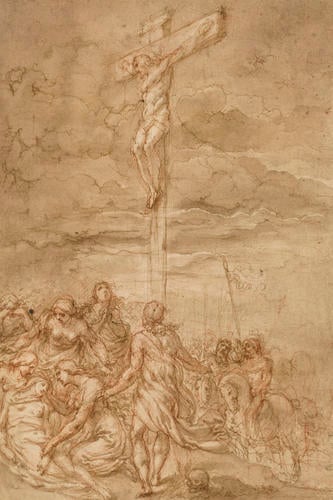-
1 of 253523 objects
The Crucifixion c.1580-1600
Pen and ink and wash, over red chalk | 20.3 x 13.7 cm (sheet of paper) | RCIN 906869

Giovanni Ambrogio Figino (1548/51-1608)
The Crucifixion c.1580-1600
-
A study of the Crucifixion.
The high degree of finish of this study of the Crucifixion makes it likely that it served as a preparatory drawing for a painting, that is now lost or was never executed. The central axis of the composition is marked by the cross and presumably the figure of St John the Evangelist in the foreground, turning his back to the beholder. His right arm points towards a mounted soldier on the right hand side. The soldier's spear leads the beholder's view up to Christ on the cross, whose tilted head relates back to the group around the figure of the Virgin Mary who has fainted in the bottom left corner of the pyramidal composition.
It is typical of Figino's drawing style to start building up his compositions and figures in red chalk first and then elaborating in pen and wash. The use of wash to model the turbulent formations of clouds in the sky, and the shading of the figures creates a dramatic atmosphere.
For other studies for the Crucifixion by Figino in the Royal Collection see RCINs 906970 and 906951 and inv.nos 951 and 733 at the Academia in Venice. See also inv.nos. 1877 and 0686 in Christ Church, Oxford; inv. no. 2.217 Grafische Sammlung Albertina, Vienna; inv.no. Z 2388-K91, Kunstsammlungen der Veste Coburg, Coburg for further studies for a crucifixion by Figino.
It is likely that this sheet together with two others (RCINs 906870 and 906871) were added to the Smith album after the album entered the Royal Collection in1762. It appears that a blank page from the back of the album (labelled page 99) has been cut and re-inserted at the front of the album in order to include these three drawings in the Figino sequence. It is likely that it took place in the nineteenth century.
Inscribed in pen on verso: Ambrogio Figino No 70
Provenance
Bequeathed by the artist to Ercole Bianchi in 1608; probably acquired by George III.
-
Creator(s)
-
Medium and techniques
Pen and ink and wash, over red chalk
Measurements
20.3 x 13.7 cm (sheet of paper)